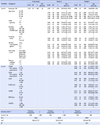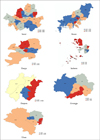2. Korea Centers for Disease Control and Prevention. 2008–2015 Regional health statistics [Internet]. Cheongju: Korea Centers for Disease Control and Prevention;2016. cited 2016 May 17. Available from:
https://chs.cdc.go.kr/chs/sub03/sub03_01.do.
3. Leng B, Jin Y, Li G, Chen L, Jin N. Socioeconomic status and hypertension: A meta-analysis. Journal of hypertension. 2015; 33(2):221–229. DOI:
10.1097/HJH.0000000000000428.
4. Lee WH, Kim HO. Association between PM10 and prevalence of hypertension: Using longitudinal analysis with 2009-2013 community health survey data. The Korean Journal of Public Health. 2015; 52(1):43–48.
5. Kim EJ, Kang MG. Effects of built environment and individual characteristics on health condition. Journal of the Korean Regional Science Association. 2011; 27(3):27–42.
6. Le C, Chongsuvivatwong V, Geater A. Contextual socioeconomic determinants of cardiovascular risk factors in rural south-west China: A multilevel analysis. BioMed Central Public Health. 2007; 7(1):72. DOI:
10.1186/1471-2458-7-72.

7. Park DY, Yoo SJ, Bae YJ, Jo NH. Prevalence rate and associated factors of hypertension in adults. The Journal of Kyungpook Nursing Science. 2008; 12(2):1–12.
8. Centers for Disease Control and Prevention. Vital signs: Prevalence, treatment and control of hypertension-United States, 1999–2002 and 2005–2008. Morbidity and Mortality Weekly Report. 2011; 60(4):103–108.
9. Song MS, Kim SH. Effects of a transtheoretical model based exercise behavior improving program on blood pressure and physical activity for older adults with hypertension. The Journal of the Korea Contents Association. 2011; 11(12):364–377. DOI:
10.5392/JKCA.2011.11.12.364.

10. Song HJ, Jang SM, Shin SY. Patterns of medical care utilization behavior and related factors among hypertensive patients: Follow-up study using the 2003–2007 Korean Health Insurance claims data. Korean Journal Health Education and Promotion. 2012; 29(2):1–12.
11. Kim OS, Jeon HO, Kim DH, Kim BH, Kim HJ. Risk factors of prehypertension in Korean adults: The Korean National Health and Nutrition Examination Survey 2005. Korean Journal of Adult Nursing. 2009; 21(3):281–292.
12. Li H, Tong W, Wang A, Lin Z, Zhang Y. Effect of cigarette smoking on blood pressure stratified by BMI in Mongolian population, China. Blood Pressure. 2010; 19(2):92–97. DOI:
10.3109/08037050903516300.
13. Chang DM, Park IS, Yang JH. Related factors of awareness, treatment, and control of hypertension in Korea: Using the Fourth Korea National Health and Nutrition Examination Survey. Journal of Digital Convergence. 2013; 3(5):6–7. DOI:
10.14400/JDPM.2013.11.11.509.
14. Lee KE, Cho EH. Factors influencing health related quality of life in patients with hypertension: Based on the 5th Korean National Health and Nutrition Examination Survey. The Journal of the Korea Contents Association. 2016; 16(5):399–409. DOI:
10.5392/JKCA.2016.16.05.399.
15. Dahlgren G, Whitehead M. Policies and strategies to promote social equity in health. Stockholm: Institute for future studies;1991. p. 69.
16. Sallis JF, Owen N, Fisher E. Ecological models of health behavior. Health behavior: theory, research, and practice. 5th ed. SanFrancisco: Jossey-Bass Publishers;2015. p. 552.
17. Lee EG. Factors associated with hypertension control in Korean adults: The Fifth Korea National Health and Nutrition Examination Survey (KNHANES V-2). Journal of the Korean Data Analysis Society. 2013; 15(6):3203–3217.
18. Lee YS. Analysis of risk factors of hypertension and evaluation of low-sodium · high-potassium nutrition education program [dissertation]. [Seoul]: Dongkuk University;2015. 200.
19. Kim GY. Drinking patterns impacting on prevalence risk of hypertension [master's thesis]. [Seoul]: Seoul National University;2015. 50.
20. Kim DH. Analysis of Small Area Variation of Health Behavior using 2008 Community Health Survey in Korea. Research Report. Seoul: Korea Centers for Disease Control and Prevention;2010. 11. Report No.: 2010E0072900.
21. Lee KH. A study on the correlation between city's built environment and residents' health: A case study of small and medium-sized cities in Korea. Journal of the Korea AcademiaIndustrial cooperation Society. 2012; 13(7):3237–3243. DOI:
10.5762/KAIS.2012.13.7.3237.

22. Park CS. Effects of individual patient behavior and medical care level on doctor's diagnosis of hypertension and therapeutic compliance: A multilevel analysis [dissertation]. [Daejeon]: Chungnam National University;2014. 59.
23. Sarki AM, Nduka CU, Stranges S, Kandala NB, Uthman OA. Prevalence of hypertension in low-and middle-income countries: A systematic review and meta-analysis. Medicine. 2015; 94(50):e1959. DOI:
10.1097/MD.0000000000001959.
25. Guo J, Zhu YC, Chen YP, Hu Y, Tang XW, Zhang B. The dynamics of hypertension prevalence, awareness, treatment, control and associated factors in Chinese adults: Results from CHNS 1991–2011. Journal of Hypertension. 2015; 33(8):1688–1696. DOI:
10.1097/HJH.0000000000000594.
26. Hwang Ik, Ko YG, Kim JH, Yoon TH, Kim CH. Small area health indicators for community-based public health projects. Research Report. Busan: Busan public Health policy Institute;2017. 04. Report No.: 2017-2.
27. Ewing R, Schmid T, Killiingsworth R, Zlot A, Raudenbush S. Relationship between urban sprawl and physical activity, obesity, morbidity. American Journal of Health Promotion. 2003; 18(1):47–57. DOI:
10.4278/0890-1171-18.1.47.
28. Oh WS, Nguyen CH, Kim SM, Sohn JW, Heo J. Spatial autocorrelation of disease prevalence in south korea using 2012 community health survey data. Journal of the Korean Society of Surveying, Geodesy, Photogrammetry and Cartography. 2016; 34(3):253–262. DOI:
10.7848/ksgpc.2016.34.3.253.

29. Lee GH. The regional health inequity, and individual and neighborhood level health determinants. Health and Social Welfare Review. 2016; 36(2):345–384. DOI:
10.15709/hswr.2016.36.2.345.
30. Shankardass K, Jerrett M, Dell SD, Foty R, Stieb D. Spatial analysis of exposure to traffic-related air pollution at birth and childhood atopic asthma in Toronto, Ontario. Health & Place. 2015; 34:287–295. DOI:
10.1016/j.healthplace.2015.06.001.







 PDF
PDF ePub
ePub Citation
Citation Print
Print








 XML Download
XML Download